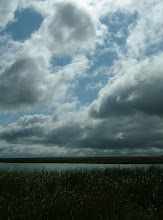
I knew it was strange, but I'd never seen it before. I managed to snap one poor photo before they flew off. Remember you can click on these photos to make them really big so you can see details. Go ahead, search on "
dragonfly mating" to read about the weird process of how and why they do this and to find out which is he and which is she and read more details and variations.
Or search on "dragonfly mating photo" so see better shots of this and of other species.
I will summarize: Dragonfly sex parts are at their tail ends like most animals. Most insects have a head, a thorax where their legs and wings are connected, and an abdomen, which in the dragonfly, is the part we call the tail. So male dragonfly sperm is emitted at the end of his long 'tail'. When he wants to mate with a female, he grabs her by the back of her head with special pincers on his tail. So now is tail is 'busy' and can't deposit sperm, right? Well, that is okay, because BEFORE he grabbed her by the head, he moved the sperm from his tail end to the bottom side of his thorax. Once he grabs her, if it 'feels right' to her, she moves her tail end, which is where the sperm needs to be, up to his abdomen where he earlier placed it. There are 'plates' in their exoskeletons there, and if they match and can link up, the sperm transfer occurs. If not, she flicks him off and
flies away.
Now, why did such a multi part mating exchange evolve? Because in the insect word, the mating is the last useful thing a male does and egg laying is the last useful thing a female does, since few species help raise the young. So for the
female to make a quick meal of the male gives her
fabulous nutrition for forming the eggs with the newly acquired sperm. It is
fairly common among predatory insects for the female to eat the male after mating. But if the male has her grasped behind the head, she can't very well eat him. But with his tail pincer busy grabbing, well that made that sperm moving step
necessary. In many dragonfly species, he remains attached to her head, and she straightens out her tail and flies off to find places in water to lay eggs. His continued attachment guarantees no other male gets to mate with her.
Isn't nature . . . amazing?













































 The insect leads a life of incomplete metamorphosis which means that it sheds its skin a number of times, growing larger each time, but does not undergo pupation. A spittlebug may molt around 5 times before it reaches its mature size, which will have wings.
The insect leads a life of incomplete metamorphosis which means that it sheds its skin a number of times, growing larger each time, but does not undergo pupation. A spittlebug may molt around 5 times before it reaches its mature size, which will have wings. 











